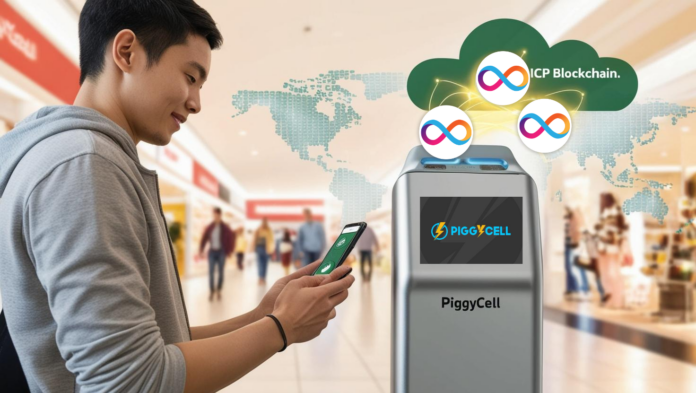Piggycell isn’t a name that turns heads for its poetry, but its approach to decentralised infrastructure might. The Korean company, known for its portable battery-sharing network, has decided it’s time for a broader audience and a deeper transformation. It now wants to pull users into the decentralised physical infrastructure networks (DePIN) conversation—without them even noticing. That’s part of the plan, and the company is getting a major push from the Internet Computer Protocol (ICP) through its HUBS Network.
So far, the numbers are tough to ignore. Piggycell has set up over 100,000 battery-sharing stations and claims a user base of more than 3.5 million. That’s a decent slice of the population already pulling power from a service that operates much like a vending machine meets power bank hybrid. Scan, borrow, charge, return, and move on. The difference now is that the charging isn’t just for devices—it’s being repurposed into data and value, all tracked on-chain.
Piggycell’s latest leap is to log all that micro-behaviour—every borrowed battery, every returned unit, every session of shared electricity—on the ICP blockchain using smart contracts, or as ICP calls them, canisters. These aren’t just ordinary logs. They are immutable and decentralised, meaning they can’t be quietly rewritten or erased. This is crucial for the reward system Piggycell is rolling out.
The mechanism is clean. Every time a person uses one of these portable batteries, they earn points. Those points don’t vanish into an opaque app ledger. Instead, they’re transparently recorded on ICP and eventually converted into PGC, Piggycell’s own utility token. PGC is native to ICP, which makes it interoperable with other ICP-based platforms and dApps. That opens up future possibilities beyond simple reward redemption—swapping, staking, or integrating into more elaborate user engagement loops.
Piggycell isn’t walking into the DePIN conversation alone. Its partnership with ICP HUBS gives it instant access to a global network that’s been pushing decentralised internet tools well before they became trendy. The ICP community is known for a slightly obsessive commitment to on-chain everything—from websites and AI models to social platforms. This makes Piggycell a curious fit—practical, physical, real-world infrastructure stepping into a space often associated with abstract tokens and theoretical Web3 ideals.
The connection is being taken seriously. The two teams aren’t just nodding at each other across press releases. They’re actively building. A closed beta is scheduled for April 2025. There will be a token airdrop during the same period, aimed at giving early adopters a taste of how the reward system works. Piggycell wants users to feel ownership, not just benefits. That’s a lofty ideal, but the underlying framework—decentralised reward data logged in real time and openly available—is at least structurally prepared for it.
The company’s move also reflects a deeper push to bridge Web2 and Web3 without demanding that users understand the transition. The backend is getting a major technical upgrade, but the front-end user experience remains stubbornly familiar. That’s by design. The app still does what it always did—let users find a battery, borrow it, and move along. The difference is, now every interaction could be linked to a token and logged immutably.
There’s a broader ambition too. Piggycell wants to show that DePIN isn’t limited to esoteric hardware like decentralised wireless hotspots or storage nodes. Everyday actions—like borrowing a battery while shopping—can feed into decentralised ecosystems. If users are rewarded consistently and transparently, they’ll start paying attention, even if they don’t care about the blockchain underneath.
The decision to build on ICP rather than other popular blockchains like Ethereum or Solana is deliberate. ICP’s architecture is well-suited to hosting complete applications on-chain without relying on AWS or other off-chain services. This means Piggycell doesn’t have to run half its stack on conventional servers. For a company working with millions of real-time user actions, that kind of vertical integration into the chain matters.
Another factor is cost. ICP’s gas model—where cycles are used instead of variable gas fees—offers a more predictable and often cheaper way to operate at scale. When logging millions of microtransactions, those savings become significant. It’s the sort of detail only engineers usually cheer about, but it can define whether a Web3 app survives or folds in its early years.
Korean brands are watching too. Piggycell has already integrated with some of the country’s largest Web2 companies. They’re not being named yet, but the partnerships are active, and the data-sharing between them is expected to shape the closed beta’s performance. This could be one of the first times Web2 companies directly witness how blockchain-backed user data functions in real-world settings—unfiltered, irreversible, and always accessible.
The timing works in Piggycell’s favour. Interest in DePIN projects has grown in early 2025 as users start looking for less abstract use cases. AI, DeFi, and NFTs have had their moments. DePIN brings back a sense of physical relevance. Piggycell’s bet is that users are ready to see how blockchain fits into routines they’ve already formed. Borrow a battery, charge your phone, and quietly accumulate PGC in the background. No extra effort required.
The roadmap is being kept lean. After April’s beta and airdrop, the full rollout is expected by Q2. It’s not yet clear whether Piggycell plans to expand its stations beyond Asia during that phase, but the underlying protocol makes global scaling less complicated. A station in Seoul works the same way as one in Berlin or São Paulo. What matters is the behaviour—charging and returning—which is consistent across cultures. If that behavioural data feeds into the same blockchain layer, expanding is mostly about hardware and logistics, not coding everything from scratch.
There’s a lingering question about whether users will care about any of this. Blockchain history is filled with clever systems ignored by the very people they were built for. Piggycell seems to understand that. Its current language isn’t loaded with crypto jargon. Even the PGC token is introduced casually. It’s a reward for using something you probably needed anyway. The chain isn’t an ideology. It’s a backend tool that earns you something for playing along.
That subtlety could work in its favour. Crypto has gone through too many hype cycles to get away with overpromising. Piggycell isn’t promising to change the entire charging experience. It’s offering something extra—earn while you power up. If that works quietly in the background and users start seeing their tokens accumulate, they might care more.
ICP’s HUBS Network, meanwhile, is keen to present this as proof that its ecosystem supports real-world businesses, not just software projects and digital experiments. Piggycell lets ICP point to something you can touch. And for a blockchain trying to show its scalability in practical use cases, that’s a useful message.
No grand gestures or celebrity endorsements are being wheeled out. No mascots, no “next Ethereum” claims. Just a battery, a borrowed few minutes of power, and the silent ticking of a blockchain canister logging every second of it. If that works, Piggycell could become one of the first DePIN projects that people use without even realising it belongs to Web3. And that might be the most effective way to win.


